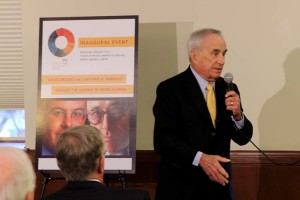Academy of Polymathic Studies hosts first event
USC’s new Academy of Polymathic Study held its inaugural event Wednesday night to promote the integration of multiple disciplines.
David Brooks, an award-winning New York Times columnist, and Antonio Damasio, a USC professor and David Dornsife chair in neuroscience, led a discussion about the science of being human Wednesday night in Doheny Memorial Library to introduce to students the types of topics that will be covered in future seminars.

Scholar · Sidney Harman, creator of the Academy of Polymathic Study, talked about polymaths, people who excel in multiple disciplines. - Chris Pham | Daily Trojan
Sidney Harman, a business professor who has been a guest lecturer in architecture, law and art classes at USC, created the academy to emphasize the exploration of the thinking process. Undergraduate and graduate students are currently applying to become a part of the academy.
The seminars aim to encourage students and faculty to engage in conversation about the exploration of critical thinking through the study of polymaths, people who master a number of topics such as Albert Einstein, Aristotle, Leonardo da Vinci, Galileo, Goethe, Thomas Jefferson and others.
“This academy, for a number of reasons will include the lessons we of the faculty have gathered from a study of the lives and the works of the polymaths,” Harman said. “They engaged, synthesized, they integrated the disciplines so that their art became philosophy and their philosophy became technology.”
Wednesday’s discussion focused on views of personhood.
Brooks said one should analyze a person’s subconscious instead of trying to comprehend their rationality and motivations.
“Many of the diagnoses that people need to do very rapidly aren’t made consciously,” Brooks said.
Damasio said it is a person’s emotions as functions of the subconscious that have evolved to direct a person’s actions.
“Think about fear, joy, anger or disgust,” Damasio said. “They’re emotions that are shared by a large number of creatures. That emotion has evolved to regulate life.”
Brooks illuminated this principle by instructing the audience to flip a coin. He said it’s not about whether the coin shows heads or tails, but about your response to the outcome.
“Flip a coin and observe your reaction to the coin flip,” Brooks said. “Don’t go by the flip. Go by the reaction.”
Though the average college student might be unaccustomed to scouring history books and psychological studies to examine what Harman calls the magic behind the achievements of Renaissance men, students who attended the event left just as much inspired as overwhelmed.
“The fact that you’re going to liken something as abstract as human behavior to something as concrete as science is very interesting to me,” said Brian Nguyen, an undeclared freshman.
Edward Saavedra, a freshman majoring in cinematic arts, said he is excited to attend the upcoming lectures.
“I found it kind of inspring, for instance the way sociology and psychology are connected,” Saavedra said.
Harman said the emphasis of the future seminars will not focus on the polymaths’ achievements, but how they became adept at multiple disciplines.
“We will reach for what we lovingly call our tapestry, which is the engagement with the interactive character of art, technology and philosophy,” Harman said.
Tara McPherson, associate professor of the School of Cinematic Arts; Warren Bennis, professor of business administration; and Geoff Cowan, professor for the Annenberg School of Communication and Journalism will lead future seminars about polymaths.
